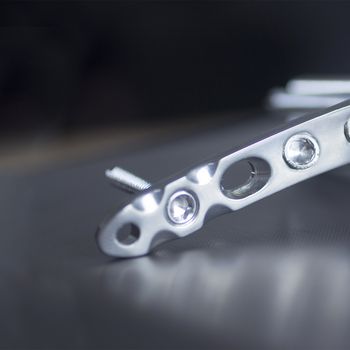
Sometimes, due to injury or disease, load bearing joints such as knees or hips must be replaced with artificial orthopaedics. Such surgeries are not only extremely painful but also expensive and risky; therefore, the longevity of these appliances is paramount: implants must be durable and generate absolutely minimal debris. Long service life is achieved through the use of tough coatings such as hard chrome or ceramics.
The replacement of a knee or hip is a major surgical procedure for renewing the weight-bearing surfaces, in order to relieve pain and restore functionality to the joint.
In order to fulfil their intended purpose, the replacement parts must meet very demanding requirements for wear resistance. Typically, there is a correlation between a material’s ability to withstand wear and its hardness; the Vickers hardness (HV) of a material is a metric that characterises this well. But traditional Vickers testers usually produce (only) a composite hardness of both the coating and the substrate, because the test loads used by these devices are too high. The accuracy of the results can suffer further from operator influence, as the diagonals of the indentation must be carefully measured – optically – under a microscope.
Nanoindentation is a well-established technique that uses very low loads to measure the HV of coatings when it is critical to avoid all influence from the substrate. The FISCHERSCOPE® HM2000 is the ideal instrument for this task, as it automatically calculates the HV from online monitoring of the penetration depth, thus eliminating any user error. Moreover, the elastic modulus can also be calculated using the slope of the unloading curve.
The study below uses the FISCHERSCOPE® HM2000 to measure hardness on an implant with a 7µm thick hard chrome coating. Applying a maximum load of 50mN produces an indentation depth well within the recommended 10% of coating thickness, as shown in Figure 1.
The HM2000’s integrated microscope and motorised XYZ stage allow for measurements to be taken directly on complex geometries like artificial knee implants – with minimal sample preparation. The average hardness of the chrome coating measured in this example was 1084.8 HV, with average elastic modulus of 279.7 GPa.
No patient or doctor wants a major joint replacement to wear out before its time. In order for surgically-implanted medical appliances to last, they must be coated properly. Nanoindentation is the method of choice for verifying this quality. The features and capabilities of the FISCHERSCOPE® HM2000 allow for accurate measurements to be made directly on the implants used in orthopaedic reconstruction. For more information, please contact your local FISCHER representative.